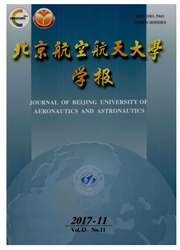

 中文摘要:
中文摘要:
由于天线阵元位置、射频(RF)放大器和模数转换器(ADC)等因素的影响,全球卫星导航系统(GNSS)抗干扰天线阵各通道间不可避免地存在着不一致性。首先,利用矩阵中的子空间理论分析了通道的幅度不一致性和相位不一致性对多重信号分类(MUSIC)算法的影响。理论分析结果表明:单干扰情况下通道幅度不一致性会降低MUSIC算法方向图的零陷深度,但不影响零陷位置,相位不一致性对MUSIC算法方向图零陷位置和零陷深度均有影响;多干扰情况下通道幅度不一致性和相位不一致性对MUSIC算法方向图零陷位置零陷和深度都有影响。因此在通道不一致性慢变化的条件下,MUSIC算法利用方向图进行性能评估时需要测出通道幅相偏差矩阵进行方向图纠正。然后,利用仿真的方法对不一致性的影响进行了实验分析,实验分析结果与理论分析结果一致。
 英文摘要:
英文摘要:
Suffering from the errors of antenna array elements such as radio frequency (RF) amplifier and analog to digital converter (ADC), global navigation satellite system (GNSS) anti-jamming antenna array has channel inconsistence inevitably. Firstly, the influences of the amplitude and phase inconsistence of channel on multiple signal classfication (MUSIC) anti-jamming algorithm are analyzed with the subspace theory of matrix. Theoretical analyses and experimental results indicate that in the case of single interference, the amplitude inconsistence decreases the nulling depth of antenna array pattern generated by MUSIC algorithm, but does not influence the nulling direction, while the phase inconsistence affects both the nulling depth and direc- tion of the antenna array pattern. In the case of multiple interferences, the amplitude inconsistence influences both the depth and direction of nulling in antenna array pattern; the phase inconsistence of channel influences both the depth and direction of hulling in antenna array pattern of MUSIC algorithm. When the channel inconsistence changes slowly, before using array pattern to evaluate the performance of the MUSIC algorithm, the array pattern should be calibrated by measuring the deviation matrix of the channel amplitude and phase. Then, the experimental analyses on the influences of the inconsistence are carried out by simulation, and the results of the experimental analyses are consistent with those of the theoretical analyses.
 同期刊论文项目
同期刊论文项目
 同项目期刊论文
同项目期刊论文
 期刊信息
期刊信息
